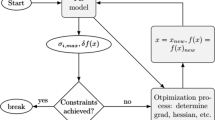Abstract
Truss structures are optimized with respect to minimum weight with constraints on the value of some displacement and on the member stresses. The truss is considered made of an uncertain material, i.e. the value of the material constants are not known in a deterministic way, and each member may then exhibit a different value of stiffness, within a limited range of variation. The optimization must be done so that optimal solutions remain feasible for each value that the material constants may take for the considered uncertainty. In the present work a nonprobabilistic approach to uncertainty is used, and a variation of the material moduli with a, probabilistically speaking, uniform distribution over a convex and linearly bounded domain is considered. The two-step method is used to include the uncertainty within the optimization, where a diagonal quadratic approximation is used for the Objective function and the constraints. Solutions for some of the most classical truss examples are found and compared with those obtained using nominal values of material constants.
Similar content being viewed by others
References
Adali, S. 1992: Convex and fuzzy modeling of uncertainties in the optimal design of composite structures. In: Pedersen P. (ed.)Optimal design with advanced materials. Amsterdam: Elsevier.
Adali, S.; Elishakoff, I.; Richter, A.; Verijenko, V. E. 1994: Optimal design of symmetric angle-ply laminates for maximum buckling load with scatter in material properties. In: Sobieski, J., (ed.) 5-th AIAA/USAF/NASA/ISSMO Symp. on Multidisciplinary Analysis and Optimization, pp. 1041–1045. Washington: AIAA
Adali S.; Richter, A.; Verijenko, V.E. 1995: Minimum weight design of symmetric angle-ply laminates under multiple uncertain loads.Struct. Optim. 9, 89–95.
Ben-Haim, Y.; Elishakoff; 1989: Non-probabilistic models of uncertainty in the non-linear buckling of shells with general imperfections: theoretical estimates of the knockdown factor.ASME J. Appl. Mech. 111, 403–410
Ben-Haim, Y.; Elishakoff, I.E. 1990:Convex models of uncertainties in applied mechanics. Studies In Applied Mechanics n. 25, The Netherlands: Elsevier
Dobbs, M.W.; Felton, L.P. 1969: Optimization of struss geometry.J. Struc. Div., ASCE 95 ST10, 2105–2118
Elishakoff, I.E. 1990: An idea on the uncertainty triangle. Editors rattle space.Shock & Vib. Digest 22, 1
Elishakoff, I.; Cai, G.Q.; Starner, J. H. 1994: Non-linear buckling of a column with initial imperfection via stochastic and non-stochastic convex models.Int. J. Non-lin. Mech. 29, 71–82
Elishakoff, I.; Haftka, R.T.; Fang, J. 1994: Structural design under bounded uncertainty-optimization with anti-optimization.Comp. & Struct. 53, 1401–1405
Fleury, C.; Braibant, V. 1986: Structural optimization: a new dual method using mixed variables.Int. J. Num. Meth. Engrg. 23, 409–428
Galante, M. 1996: Genetic algorithm as an approach to optimize real-world trusses.Int. J. Num. Meth. Engrg. 39, 361–382
Gangadharan, S.N.; Nikolaidis, E.; Lee, K.; Haftka, R.T. 1993: The use of anti-optimization to compare alternative structural models.34-th AIAA/ASME/ASCE/AHS/ASC SDM Conf., pp. 534–543. Washington: AIAA
Kuritz, S.P.; Fleury, C. 1989: Mixed variable structural optimization using convex linearization techniques.Eng. Opt. 15, 27–41
Lee, J.; Haftka, R.T.; Griffin, O.H., Jr.; Watson, L.T.; Sensmeier, M.D. 1994: Detecting delamination in a composite beam using anti-pptimization.Struct. Optim. 8, 93–100
Lombardi, M. 1998: Optimization of uncertain structures using non-probabilistic models.Comp. & Struct. (in press)
Lombardi, M.; Cinquini, C.; Contro, R.; Haftka, R.T. 1995: Anti-optimization technique for designing composite structures. In: Olhoff, N.; Rozvany, G.I.N. (eds.)Proc. WCSMO-1, First World Congress of Structural and Multidisciplinary Optimization, pp. 251–278. Oxford: Pergamon
Lombardi, M.; Haftka, R.T. 1998: Anti-optimization technique for designing composite structures.Comp. Meth. App. Mech. Eng. (in press)
Svanberg, K. 1981: Optimization of geometry in truss design.Comp. Meth. Appl. Mech. Engrg. 28, 63–80
Vanderplaats G.N.; Moses F. 1972: Automated design of trusses for optimum geometry.J. Struc. Div., ASCE 98 ST3, 671–690
van Wamelen, A.; Johnson, E.R.; Haftka, R.T. 1993: Optimal design of laminate specimens to evaluate competing composite failure criteria. Presented at:8-th ASC Technical Conf. on Composite Materials (held in Cleveland, OH)
Zhang, W.H.; Fleury, C. (1994): Recent advances in convex approximation methods for structural optimization. In: Topping, B.H.V.; Papadrakakis M. (eds)Advances in structural optimization, pp. 83–90. Edinburgh: Civil-Comp Press
Zhang, W.H.; Fleury, C. (1995): Structural shape optimization and convex programming methods.Proc. Int. Symp. on Optimization of Mechanical Systems (held in Stuttgart, Germany)
Author information
Authors and Affiliations
Rights and permissions
About this article
Cite this article
Barbieri, E., Lomhardi, M. Minimum weight shape and size optimization of truss structures made of uncertain materials. Structural Optimization 16, 147–154 (1998). https://doi.org/10.1007/BF01202825
Received:
Issue Date:
DOI: https://doi.org/10.1007/BF01202825




